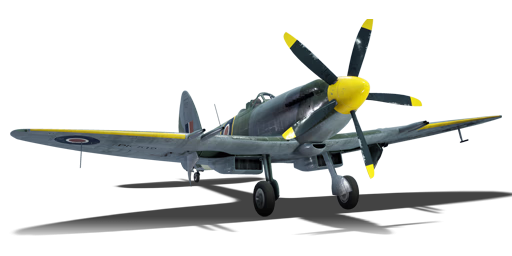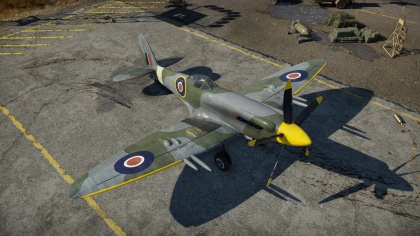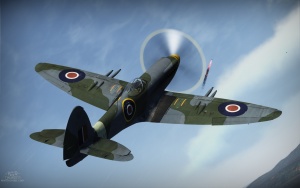Difference between revisions of "Spitfire F Mk 22"
Matchstick21 (talk | contribs) m (→Pros and cons: Made sentence clearer.) (Tag: Visual edit) |
(Edits.) |
||
| Line 1: | Line 1: | ||
{{Specs-Card|code=spitfire_f22}} | {{Specs-Card|code=spitfire_f22}} | ||
| − | {{ | + | {{About |
| + | | about = British fighter '''{{PAGENAME}}''' | ||
| + | | usage = other uses | ||
| + | | link = Spitfire (Family) | ||
| + | }} | ||
== Description == | == Description == | ||
| − | <!--''In the description, the first part needs to be about the history of and the creation and combat usage of the aircraft, as well as its key features. In the second part, tell the reader about the aircraft in the game. Insert screenshot of the vehicle. If the novice player does not remember the vehicle by name, he will immediately understand what kind of vehicle it is talking about.''--> | + | <!--''In the description, the first part needs to be about the history of and the creation and combat usage of the aircraft, as well as its key features. In the second part, tell the reader about the aircraft in the game. Insert a screenshot of the vehicle. If the novice player does not remember the vehicle by name, he will immediately understand what kind of vehicle it is talking about.''--> |
[[File:GarageImage_{{PAGENAME}}.jpg|420px|thumb|left]] | [[File:GarageImage_{{PAGENAME}}.jpg|420px|thumb|left]] | ||
{{break}} | {{break}} | ||
| − | The '''{{Specs|name}}''' is a | + | The '''{{Specs|name}}''' is a rank {{Specs|rank}} British fighter {{Battle-rating}}. This fighter was introduced in [[Update 1.39]]. |
== General info == | == General info == | ||
=== Flight Performance === | === Flight Performance === | ||
| Line 130: | Line 134: | ||
* 42.8 mm Bulletproof glass - Armored windscreen | * 42.8 mm Bulletproof glass - Armored windscreen | ||
* 4 mm Steel - Armored pilot seat | * 4 mm Steel - Armored pilot seat | ||
| − | * 4 mm Steel - Armor plate behind pilot seat | + | * 4 mm Steel - Armor plate behind the pilot seat |
| − | * 7 mm Steel - Armor plate behind pilot seat | + | * 7 mm Steel - Armor plate behind the pilot seat |
* 3 mm Steel - Armored boxes around the wing ammunition (each wing) | * 3 mm Steel - Armored boxes around the wing ammunition (each wing) | ||
* 12.7 mm Steel - Armored plate between fuel tanks. | * 12.7 mm Steel - Armored plate between fuel tanks. | ||
| − | * 6 mm Steel - Armored plate in front of liquid cooling system. | + | * 6 mm Steel - Armored plate in front of the liquid cooling system. |
== Armaments == | == Armaments == | ||
| Line 147: | Line 151: | ||
<!--=== Suspended armament === | <!--=== Suspended armament === | ||
''Describe the aircraft's suspended armament: additional cannons under the wings, bombs, rockets and torpedoes. This section is especially important for bombers and attackers. If there is no suspended weaponry remove this subsection.''--> | ''Describe the aircraft's suspended armament: additional cannons under the wings, bombs, rockets and torpedoes. This section is especially important for bombers and attackers. If there is no suspended weaponry remove this subsection.''--> | ||
| − | + | {{main|G.P. 250 lb Mk.IV (250 lb)|G.P. 500 lb Mk.IV (500 lb)|RP-3}} | |
The '''''{{PAGENAME}}''''' can be outfitted with the following ordinance: | The '''''{{PAGENAME}}''''' can be outfitted with the following ordinance: | ||
| Line 166: | Line 170: | ||
<!--''Describe the tactics of playing in an aircraft, the features of using vehicles in a team and advice on tactics. Refrain from creating a "guide" - do not impose a single point of view but give the reader food for thought. Examine the most dangerous enemies and give recommendations on fighting them. If necessary, note the specifics of the game in different modes (AB, RB, SB).''--> | <!--''Describe the tactics of playing in an aircraft, the features of using vehicles in a team and advice on tactics. Refrain from creating a "guide" - do not impose a single point of view but give the reader food for thought. Examine the most dangerous enemies and give recommendations on fighting them. If necessary, note the specifics of the game in different modes (AB, RB, SB).''--> | ||
[[File:FighterImage_Spitfire_F_Mk_24.jpg|thumbnail|right|The new wing shape and larger control surfaces of the 22/24 series are a distinctive feature of the aircraft.]] | [[File:FighterImage_Spitfire_F_Mk_24.jpg|thumbnail|right|The new wing shape and larger control surfaces of the 22/24 series are a distinctive feature of the aircraft.]] | ||
| − | The Spitfire F Mk 22 an excellent plane in realistic battle with few weakness, henceforth the enemy will have a really hard time shaking the Spitfire off of its tail and only few will succeed. | + | The Spitfire F Mk 22 an excellent plane in realistic battle with relatively few weakness, henceforth the enemy will have a really hard time shaking the Spitfire off of its tail and only few will succeed. |
| − | It is very important to avoid hard turning or rolling above 500 kph IAS, because the plane may | + | It is very important to avoid hard turning or rolling above 500 kph IAS, because the plane may lose its wing. |
| − | The main task for a pilot is to utilize the great climb rate (altitude = control engagements). Target altitude should usually be around 5-6 km on smaller maps and 6-7 km on larger maps such as Norway and Spain. The main form of attack (especially when there are more fighters around the target) is Boom & Zoom. Energy fighting is an option too, if in 1 vs 1 situation. The Griffon Spitfire is excellent energy fighter, the namesake Griffon engine provides a | + | The main task for a pilot is to utilize the great climb rate (altitude = control engagements). Target altitude should usually be around 5-6 km on smaller maps and 6-7 km on larger maps such as Norway and Spain. The main form of attack (especially when there are more fighters around the target) is Boom & Zoom. Energy fighting is an option too, if in 1 vs 1 situation. The Griffon Spitfire is an excellent energy fighter, the namesake Griffon engine provides a tremendous amount of horsepower which can be used instead of energy retention (-> Boom & Zoom). Remember to maintain speed, altitude advantage, and judge the enemies energy state. |
====Specific enemies worth noting==== | ====Specific enemies worth noting==== | ||
<!--Some concerning vehicles to worry about if playing this plane. (i.e. Japanese fighters will out turn you)--> | <!--Some concerning vehicles to worry about if playing this plane. (i.e. Japanese fighters will out turn you)--> | ||
| − | Griffon Spitfire can keep up with most enemies in turn fights, excluding most Japanese fighters and Bf 109s, both of which are more agile. Try to maintain a speed of between 500-400 kph IAS; this is where the plane | + | Griffon Spitfire can keep up with most enemies in turn fights, excluding most Japanese fighters and Bf 109s, both of which are more agile. Try to maintain a speed of between 500-400 kph IAS; this is where the plane maintains great agility, turning bellow this velocity against planes such as the [[Bf 109 G-14|109G-14]] is really not recommended. When fighting Soviet fighters it is NOT recommended to duel them between 1-4 km altitude. |
===Manual Engine Control=== | ===Manual Engine Control=== | ||
| Line 242: | Line 246: | ||
# Wings Repair | # Wings Repair | ||
# Fuel Injection | # Fuel Injection | ||
| − | # Cover (many of the upgrades are crucial to | + | # Cover (many of the upgrades are crucial to boosting the aircraft's speed and climb rate) |
=== Pros and cons === | === Pros and cons === | ||
| Line 249: | Line 253: | ||
'''Pros:''' | '''Pros:''' | ||
| − | * 4 x cannons with high rate of fire | + | * 4 x cannons with a high rate of fire |
* Excellent climb rate | * Excellent climb rate | ||
* Quite agile at medium and higher speeds | * Quite agile at medium and higher speeds | ||
| Line 258: | Line 262: | ||
'''Cons:''' | '''Cons:''' | ||
| − | * From time to time, | + | * From time to time, pitted against jets which can be tricky to outmanoeuvre |
* Mediocre roll rate | * Mediocre roll rate | ||
* Poor agility at lower speeds and significant drag/mass ratio at high speeds limits optimal combat speed range | * Poor agility at lower speeds and significant drag/mass ratio at high speeds limits optimal combat speed range | ||
| − | * | + | * Easily set on fire due to the location of the fuel tanks |
| − | * Landing gear rips very easily | + | * Landing gear rips very easily during take-off and landing travelling in excess of 260 kph |
| − | * Landing flaps also break off at roughly the same speed as the gear | + | * Landing flaps also break off at roughly the same speed as the gear |
| − | * Somewhat | + | * Somewhat sluggish without utilizing WEP |
== History == | == History == | ||
Revision as of 22:03, 16 May 2019
Contents
| This page is about the British fighter Spitfire F Mk 22. For other uses, see Spitfire (Family). |
Description
The Spitfire F Mk 22 is a rank IV British fighter
with a battle rating of 5.7 (AB), 6.7 (RB), and 6.0 (SB). This fighter was introduced in Update 1.39.
General info
Flight Performance
| Characteristics | |||||||
|---|---|---|---|---|---|---|---|
| Stock | |||||||
| Max Speed (km/h at 8,232 m) |
Max altitude (meters) |
Turn time (seconds) |
Rate of climb (meters/second) |
Take-off run (meters) | |||
| AB | RB | AB | RB | AB | RB | ||
| 703 | 687 | 11,800 | 19.6 | 20.8 | 16.0 | 18.5 | 420 |
| Upgraded | |||||||
| Max Speed (km/h at 8,232 m) |
Max altitude (meters) | Turn time (seconds) | Rate of climb (meters/second) |
Take-off run (meters) | |||
| AB | RB | AB | RB | AB | RB | ||
| 784 | 740 | 11,800 | 17.8 | 18.2 | 35.7 | 23.7 | 420 |
Details
| Features | ||||
|---|---|---|---|---|
| Combat flap | Take-off flap | Landing flap | Air brakes | Arrestor gear |
| ✓ | ✓ | ✓ | X | X |
| Limits | ||||
|---|---|---|---|---|
| Wing-break speed (km/h) |
Gear limit (km/h) |
Combat flap (km/h) |
Max Static G | |
| + | - | |||
| 875 | 260 | ??? | ~12 | ~7 |
| Optimal velocities | |||
|---|---|---|---|
| Ailerons (km/h) |
Rudder (km/h) |
Elevators (km/h) |
Radiator (km/h) |
| < 482 | < 400 | < 470 | > 250 |
| Compressor (RB/SB) | ||
|---|---|---|
| Setting 1 | ||
| Optimal altitude | 100% Engine power | WEP Engine power |
| 4,600 m | 1,510 hp | 2,190 hp |
| Setting 2 | ||
| Optimal altitude | 100% Engine power | WEP Engine power |
| 8,600 m | 1,360 hp | 1,933? hp |
Survivability and armour
- 42.8 mm Bulletproof glass - Armored windscreen
- 4 mm Steel - Armored pilot seat
- 4 mm Steel - Armor plate behind the pilot seat
- 7 mm Steel - Armor plate behind the pilot seat
- 3 mm Steel - Armored boxes around the wing ammunition (each wing)
- 12.7 mm Steel - Armored plate between fuel tanks.
- 6 mm Steel - Armored plate in front of the liquid cooling system.
Armaments
Offensive armament
The Spitfire F Mk 22 is armed with:
- 4 x 20 mm Hispano Mk.II cannons, wing-mounted (175 rpg inner + 150 rpg outer = 650 total)
The Spitfire F Mk 22 can be outfitted with the following ordinance:
- Without load
- 2 x G.P. 250 lb Mk.IV bombs (500 lb total)
- 3 x G.P. 250 lb Mk.IV bombs (750 lb total)
- 2 x G.P. 500 lb Mk.IV bombs (1,000 lb total)
- 1 x G.P. 500 lb Mk.IV bomb + 2 x G.P. 500 lb Mk.IV bombs (1,500 lb total)
- 3 x G.P. 500 lb Mk.IV bombs (1,500 lb total)
- 6 x 76 mm RP-3 rockets
Usage in the battles
The Spitfire F Mk 22 an excellent plane in realistic battle with relatively few weakness, henceforth the enemy will have a really hard time shaking the Spitfire off of its tail and only few will succeed.
It is very important to avoid hard turning or rolling above 500 kph IAS, because the plane may lose its wing.
The main task for a pilot is to utilize the great climb rate (altitude = control engagements). Target altitude should usually be around 5-6 km on smaller maps and 6-7 km on larger maps such as Norway and Spain. The main form of attack (especially when there are more fighters around the target) is Boom & Zoom. Energy fighting is an option too, if in 1 vs 1 situation. The Griffon Spitfire is an excellent energy fighter, the namesake Griffon engine provides a tremendous amount of horsepower which can be used instead of energy retention (-> Boom & Zoom). Remember to maintain speed, altitude advantage, and judge the enemies energy state.
Specific enemies worth noting
Griffon Spitfire can keep up with most enemies in turn fights, excluding most Japanese fighters and Bf 109s, both of which are more agile. Try to maintain a speed of between 500-400 kph IAS; this is where the plane maintains great agility, turning bellow this velocity against planes such as the 109G-14 is really not recommended. When fighting Soviet fighters it is NOT recommended to duel them between 1-4 km altitude.
Manual Engine Control
| MEC elements | ||||||
|---|---|---|---|---|---|---|
| Mixer | Pitch | Radiator | Supercharger | Turbocharger | ||
| Oil | Water | Type | ||||
| Controllable | Not controllable | Not controllable | Not controllable | Separate | Not ontrollable | Not controllable |
Modules
| Tier | Flight performance | Survivability | Weaponry | ||
|---|---|---|---|---|---|
| I | Fuselage Repair | Radiator | HSBC mk.2 | HSBC mk.3 | |
| II | Compressor | Airframe | HMBC mk.2 | HMBC mk.3 | |
| III | Wings Repair | Engine | Offensive 20 mm | HRC mk.8 | |
| IV | Engine Injection | Cover | New 20 mm Cannons | ||
- The Griffon is Energy fighter/Boom & Zoom plane (suggested upgrade order):
- Fuselage Repair
- Radiator
- Compressor
- Airframe
- Offensive 20 mm
- Engine
- Wings Repair
- Fuel Injection
- Cover (many of the upgrades are crucial to boosting the aircraft's speed and climb rate)
Pros and cons
Pros:
- 4 x cannons with a high rate of fire
- Excellent climb rate
- Quite agile at medium and higher speeds
- Very responsive elevator(starts to lock at speeds above 600 kph IAS)
- Brutal acceleration when using WEP
- Good performance at higher altitudes
Cons:
- From time to time, pitted against jets which can be tricky to outmanoeuvre
- Mediocre roll rate
- Poor agility at lower speeds and significant drag/mass ratio at high speeds limits optimal combat speed range
- Easily set on fire due to the location of the fuel tanks
- Landing gear rips very easily during take-off and landing travelling in excess of 260 kph
- Landing flaps also break off at roughly the same speed as the gear
- Somewhat sluggish without utilizing WEP
History
Describe the history of the creation and combat usage of the aircraft in more detail than in the introduction. If the historical reference turns out to be too big, take it to a separate article, taking a link to an article about the vehicle and adding a block "/ historical reference" (example: https://wiki.warthunder.com/Name-vehicles/historical reference) and add a link to it here using the main template. Be sure to include links to sources at the end of the article.
Media
An excellent addition to the article will be video guides, as well as screenshots from the game and photos.
Read also
Links to the articles on the War Thunder Wiki that you think will be useful for the reader, for example,
- reference to the series of the aircraft;
- links to approximate analogues of other nations and research trees.
Sources
Paste links to sources and external resources, such as:
- topic on the official game forum;
- page on aircraft encyclopedia;
- other literature.






